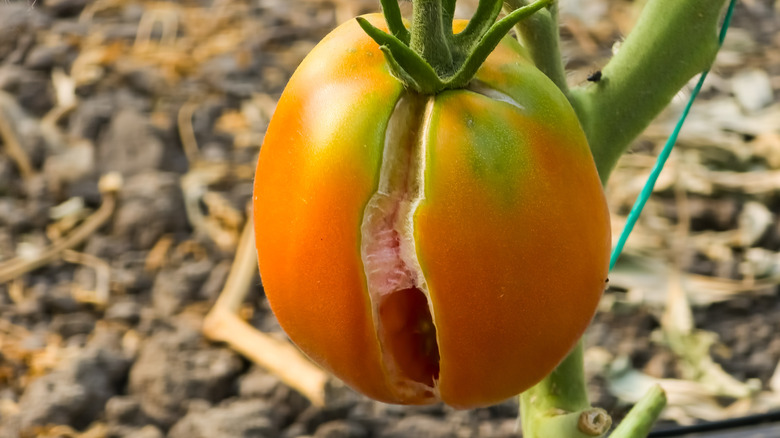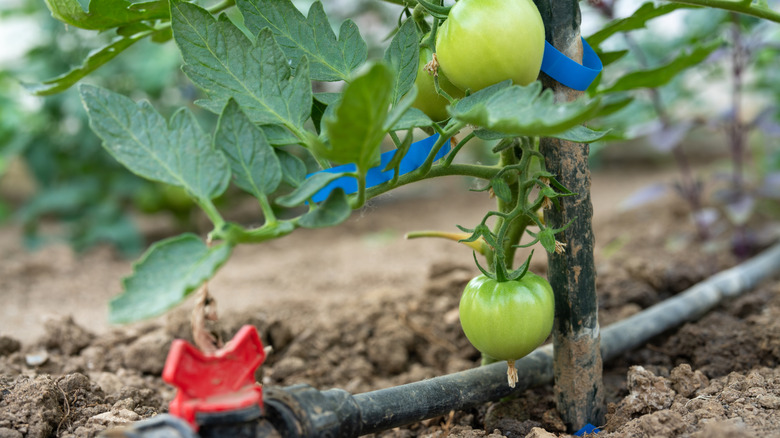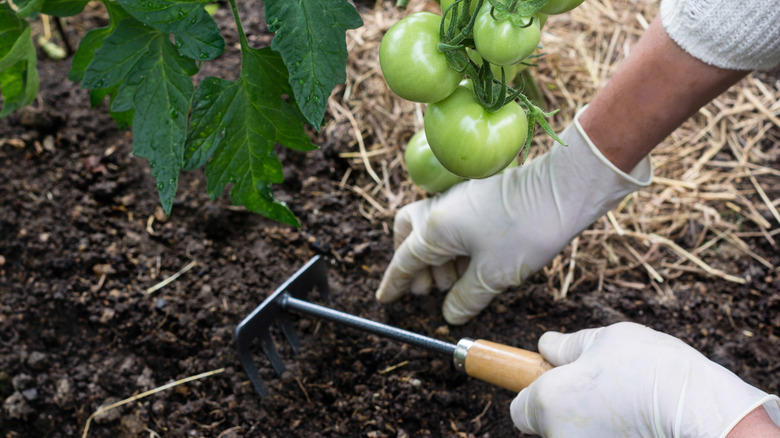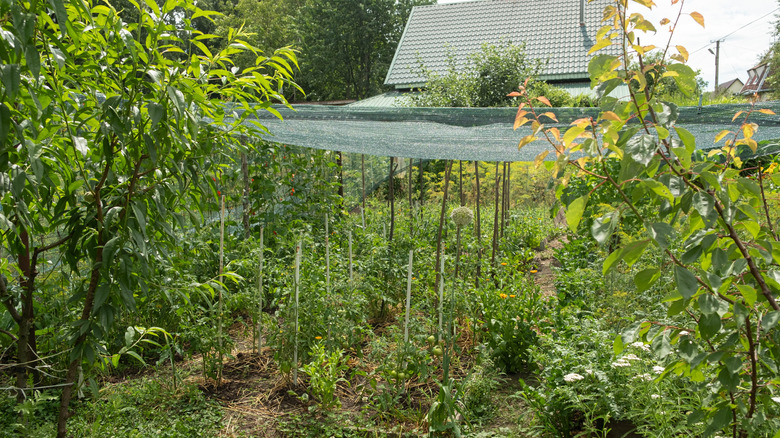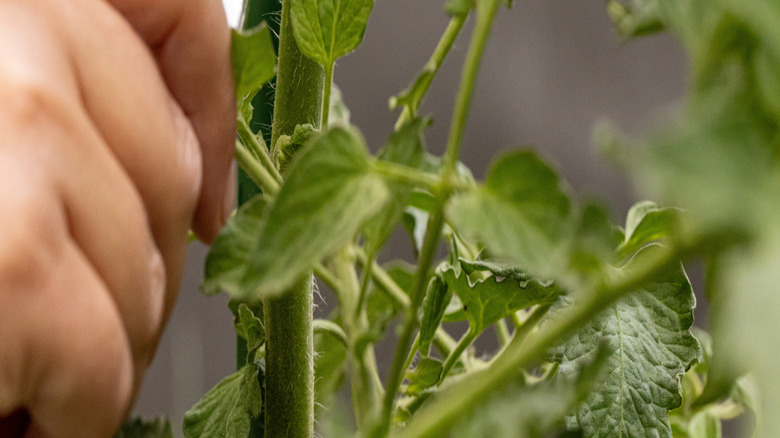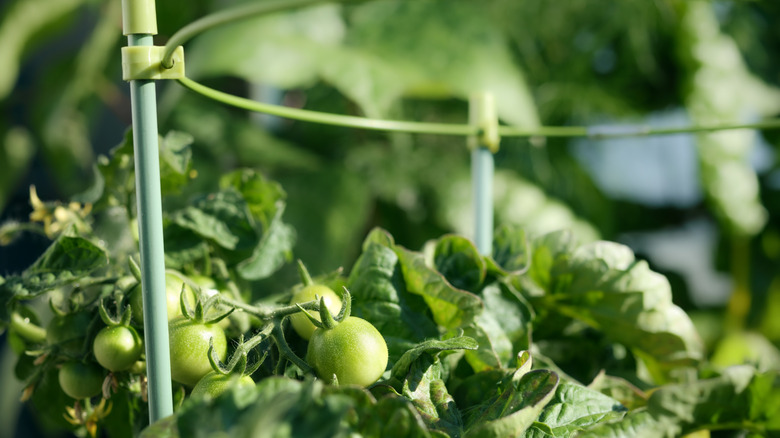Keep Your Tomatoes From Cracking And Splitting With These Easy Tips And Tricks
Seeing a cracked tomato after weeks of waiting for a perfectly ripe one is one of gardening's biggest letdowns. One day the fruit looks great, and the next, its skin has suddenly split or it has rings around the stem end. These blemishes do more than just ruin the look of the harvest, they make the tomato more susceptible to pests, mold, and decay, which limits the amount of tomatoes you can harvest. The good news is that these issues are rarely caused by disease, but by the growing conditions, creating an issue known as a physiological disorder.
This happens when growing conditions make the flesh inside the tomato expand at a rate faster than the outer skin can match. The sudden swelling is almost always linked to inconsistent watering. When a dry plant quickly absorbs a lot of water, the fruit rapidly plumps up, forcing the skin to burst. Understanding why this happens is an important way to prevent your tomatoes from cracking and splitting. By using these five tips to keep the growing conditions consistent, you can look forward to picking beautiful tomatoes in no time.
Water consistently
The most important thing to do to prevent tomatoes from splitting is to maintain an even moisture level in the soil. The plant needs a steady supply of water, not alternating periods of too little and then too much water. During the height of summer, most tomato plants need about 1 to 2 inches of water every week, offered in a way that saturates the soil deeply, reaching about 6 to 8 inches below the surface. Watering deeply encourages the plant's roots to grow deeper into the soil, making them more resilient and less prone to surface drying and stress during hot weather.
Shallow watering should be avoided because it only dampens the top layer of the soil. This trains the roots to stay near the surface, where the water evaporates quickly, leading to rapid moisture loss and increased risk of cracking. The ideal approach is to water thoroughly two to three times a week or more, depending on the weather and if the tomato plants are planted in containers or in the ground. The best time to water is in the morning, since that allows the plant to use the water throughout the day to survive the heat and lets any water on the leaves dry quickly, which reduces the risk of fungal diseases. Water the plants at the base using a drip system or soaker hose to keep the leaves as dry as possible.
Insulate the soil
Mulch works as a natural barrier to stabilize the soil around the plants. By laying down organic mulch around the base of your tomato plants, you are placing a protective shield over the soil that helps reduce the risk of fruit damage. The mulch cuts down the rate of water evaporation from the surface of the soil, which helps to maintain a consistent moisture level between waterings or rainfall. This is helpful during periods of high heat or when the weather switches from hot and dry to rainy.
Mulch also acts as an insulating layer, helping to moderate soil temperature. In very hot climates, it prevents the sun from baking the ground, which keeps the plant's roots cooler so the tomatoes don't overheat—a state that can lead to stress and cracking. Good organic materials for tomatoes include clean straw, shredded leaves, or compost, all applied in a layer about 2 to 4 inches thick. Avoid wood-based mulches such as wood chips or pine bark, since they can sometimes alter the soil's pH as they break down. Putting the mulch in a wide circle around the stem of the plant protects the entire root zone, suppresses weed growth, and keeps the soil healthy.
Give plants relief from the sun
While tomatoes love the sun, too much intense heat can stress out the plant, which causes the fruit's skin to toughen and lose its elasticity, leading to cracks. This stress also contributes to sunscald, where spots on the fruit turn white or yellow. Providing some shade during the hottest parts of the day can help.
One way to do this is by using a shade cloth, a material that's designed to filter sunlight without blocking air circulation. When buying this material, look for one that provides between 30 and 50% shading. This range allows enough light for the plants to ripen their fruit while avoiding heat stress. The cloth should be hung above the plants rather than draped on the plant to allow airflow and prevent heat buildup. Using a sun shade can reduce the temperature around a plan by as much as 10 degrees. Technically, you only need to use this type of protection when temperatures are consistently above 85 degrees Fahrenheit. Another solution is to position the plants where they get sun in the morning and shade during the afternoon heat.
Shape plant growth
Pruning your tomato plants supports fruit health and reduces the likelihood of splitting. Tomato plants that are allowed to grow into a dense, bushy mass often create high humidity levels around the fruit. By removing unnecessary leaves, you can increase the air circulation around the tomatoes, allowing moisture on the leaves and fruit to dry faster after it rains. Improved airflow reduces the humidity, minimizing the pressure on the fruit skin and helping to prevent disease.
Pruning also helps to divert the plant's energy. When you remove the suckers, the small shoots that grow between the main stem and the leaf branches, the plant redirects its energy away from making new growth and toward the tomatoes. This results in healthier fruit that is less susceptible to splitting. Start by removing all unhealthy lower leaves then carefully remove suckers, leaving a few healthy stems to grow and fruit.
Support the plants
As tomato plants mature, their vines become heavy, especially when growing large tomatoes. If these branches are allowed to slump on the ground or lean against the main stem, they can become weak and make the tomatoes more vulnerable to damage and cracking. Providing extra support distributes the weight evenly, reducing the strain on the plant's branches and stems. One popular option is to use cages, especially those made of heavy-duty, reinforced wire. The cages should be tall, at least 5 feet, and about 24 to 30 inches in diameter, to allow for full growth. Cages keep the tomatoes off the ground, preventing contact that can increase moisture and risk of rot.
Staking is another option. Here, the main vine is tied to a tall stake that's been driven deep into the soil. For indeterminate tomato varieties, trellises are a good option because they allow the vines to be trained upward, take up less ground space, and provide good airflow. Putting whatever type of support you choose in place right after the plant is in the soil prevents root disturbance later on and gives the plant a solid foundation for healthy growth.
